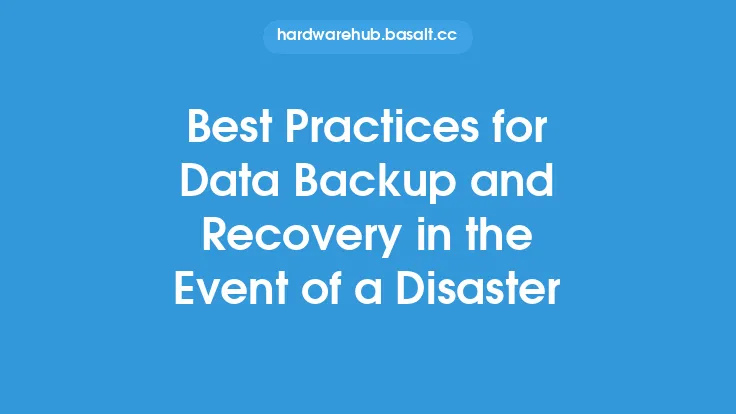In today's digital age, computers have become an essential part of our daily lives, storing vast amounts of valuable data, including personal files, documents, photos, and videos. However, with the increasing reliance on computers, the risk of data loss has also increased. Data loss can occur due to various reasons such as hardware failure, software corruption, viruses, accidental deletion, and natural disasters. This is where data backup and recovery come into play, serving as a safety net to protect your valuable data from loss or corruption.
Introduction to Data Backup
Data backup refers to the process of creating copies of your data and storing them in a secure location, such as an external hard drive, cloud storage, or tape drive. This ensures that your data is safe and can be recovered in case of a disaster or data loss. There are several types of data backup, including full backup, incremental backup, and differential backup. A full backup involves creating a complete copy of all your data, while incremental and differential backups involve creating copies of only the data that has changed since the last backup.
Importance of Data Recovery
Data recovery, on the other hand, refers to the process of restoring your data from a backup in case of a disaster or data loss. This can be a time-consuming and complex process, requiring specialized software and expertise. Data recovery is crucial because it enables you to recover your valuable data, including documents, photos, and videos, and restore your computer to its original state. Without data recovery, you risk losing your valuable data forever, which can have serious consequences, including financial loss, reputational damage, and emotional distress.
Types of Data Loss
There are several types of data loss, including physical damage, logical damage, and software-related issues. Physical damage occurs when a storage device, such as a hard drive or solid-state drive, is damaged due to a physical event, such as a drop or a power surge. Logical damage, on the other hand, occurs when a storage device is corrupted due to a software issue, such as a virus or a faulty operating system. Software-related issues can also cause data loss, including file system corruption, operating system failure, and application errors.
Data Backup and Recovery Methods
There are several data backup and recovery methods, including local backup, cloud backup, and hybrid backup. Local backup involves creating copies of your data on an external hard drive or tape drive, while cloud backup involves storing your data in a cloud storage service, such as Google Drive or Dropbox. Hybrid backup involves combining local and cloud backup methods, providing an additional layer of protection and flexibility. Each method has its advantages and disadvantages, and the choice of method depends on your specific needs and requirements.
Best Practices for Data Backup and Recovery
To ensure effective data backup and recovery, it is essential to follow best practices, including creating regular backups, testing backups, and storing backups in a secure location. Regular backups ensure that your data is up-to-date and can be recovered in case of a disaster or data loss. Testing backups ensures that your backups are complete and can be recovered successfully. Storing backups in a secure location, such as an external hard drive or cloud storage, ensures that your backups are safe from physical damage, theft, or unauthorized access.
Technical Aspects of Data Backup and Recovery
From a technical perspective, data backup and recovery involve several complex processes, including data compression, encryption, and deduplication. Data compression reduces the size of your data, making it easier to store and transfer. Encryption protects your data from unauthorized access, ensuring that only authorized personnel can access your backups. Deduplication eliminates duplicate copies of your data, reducing storage requirements and improving backup efficiency. Additionally, data backup and recovery software use various algorithms and techniques, such as incremental and differential backups, to optimize backup and recovery processes.
Common Challenges in Data Backup and Recovery
Despite the importance of data backup and recovery, several challenges can arise, including data corruption, backup failures, and restore issues. Data corruption occurs when your data is damaged or corrupted during the backup or recovery process. Backup failures occur when your backups are incomplete or cannot be recovered. Restore issues occur when your data cannot be restored successfully, resulting in data loss or corruption. To overcome these challenges, it is essential to use reliable data backup and recovery software, follow best practices, and test your backups regularly.
Future of Data Backup and Recovery
The future of data backup and recovery is rapidly evolving, with emerging technologies, such as artificial intelligence, machine learning, and blockchain, playing a significant role. Artificial intelligence and machine learning can improve data backup and recovery processes, enabling predictive analytics, automated backup and recovery, and enhanced data protection. Blockchain technology can provide an additional layer of security and integrity, ensuring that your backups are tamper-proof and secure. As data backup and recovery continue to evolve, it is essential to stay informed and adapt to new technologies and best practices to ensure the protection and integrity of your valuable data.
Conclusion
In conclusion, data backup and recovery are crucial for protecting your valuable data from loss or corruption. With the increasing reliance on computers, the risk of data loss has also increased, making it essential to create regular backups and have a data recovery plan in place. By understanding the importance of data backup and recovery, following best practices, and using reliable software, you can ensure the protection and integrity of your data, minimizing the risk of data loss and corruption. Whether you are an individual or an organization, data backup and recovery are essential for maintaining the continuity and integrity of your digital assets.





